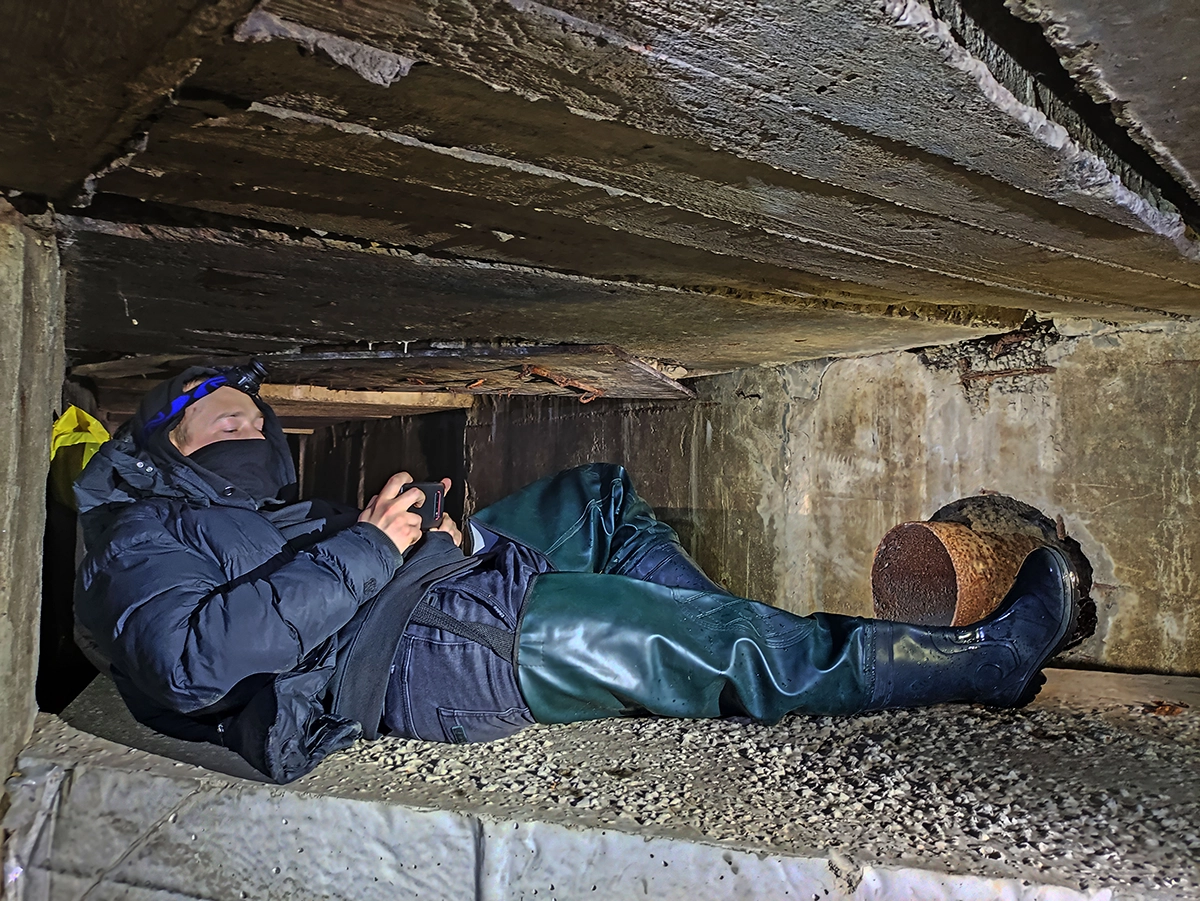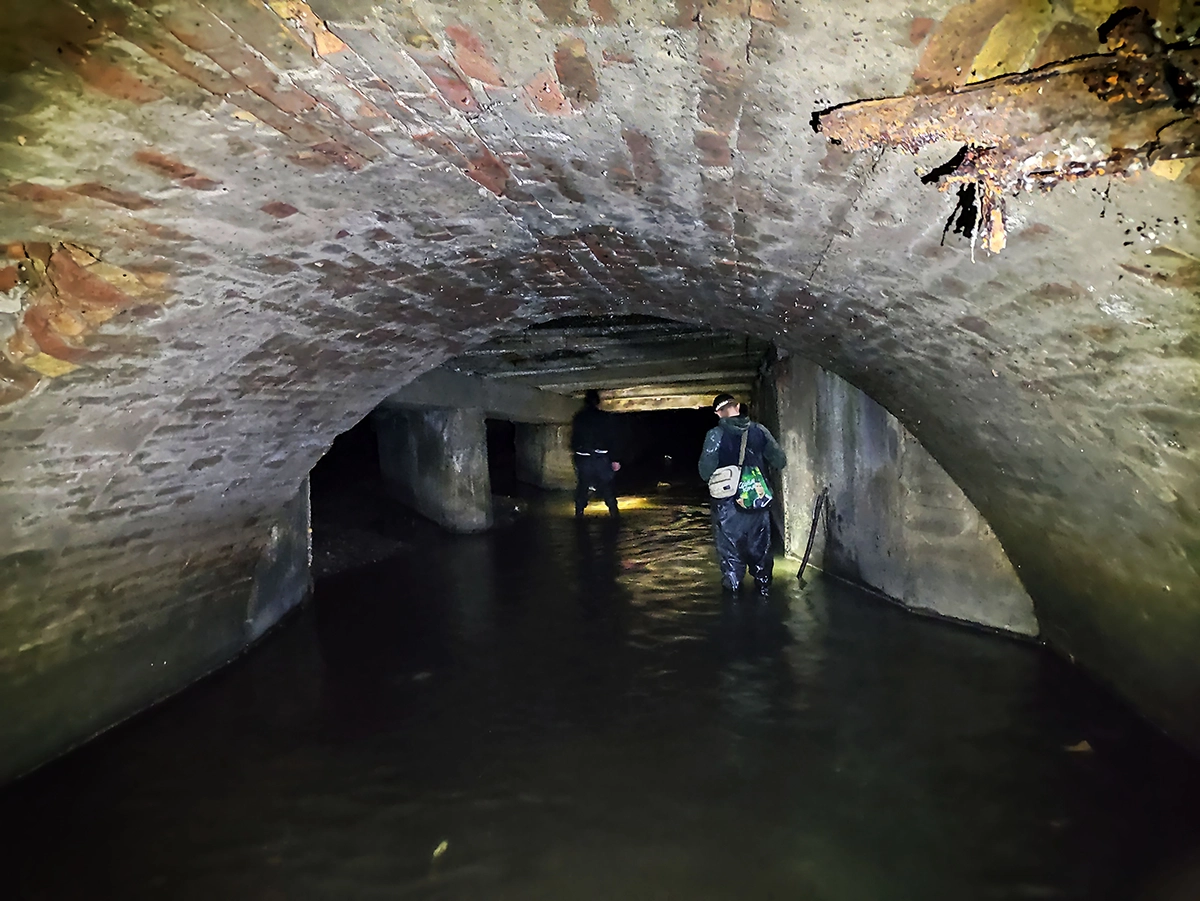
Underground world of the Dnipro / from Zhabokryacha to Zaporizhzhya watercourse
In fact, the underground part of the Dnieper city is little explored. The most famous tourist route(which most citizens know about) is the part of the Zhabokryach River(which people consider to be the Polovitsa River due to the mistakes of some “historians”) that is shrouded in an ancient collector. But the same Polovitsa once had several tributaries, most of which still exist today – they partially flow along the lowlands of the city ravines gradually turning first into drainage pipes, and further(closer to the city center) into full-fledged underground rivers in storm waterways. Only some municipal workers(who periodically have to clean these systems) and the city’s desperate diggers(who search for the city’s secret places) know about these watercourses.
One of these systems is the Zaporizhzhya storm water stream, an equally interesting engineering structure with historical sections, so I went down into this underground river with my friends.
Earlier I have already written about the underground system of the river Zhabokryach(photo 1), about ancient “underground” bridges, which over time have become part of storm sewers. Also(for especially biased citizens) in my videos I had the opportunity to prove the fact that(probably named by Cossacks) the small river Zhabokryach is not Polovitsa, and that Polovitsa disappeared as a hydronym a long time ago. But the Zaporizhzhya watercourse, as well as most of the stormwater systems of our city, have a common past with the Polovitsa – because it too was once its tributary.
Zaporizhzhya watercourse is “born” from the streams(and now from storm water receivers and drainage systems) in the park “Zelenyi Gai” at the beginning of the gully, and flows further along it, which had many names.
On the old map of the city from 1821, which is available on the OldMaps project website, this gully is listed as “Maple Bayrak” – and this is its historical name. But besides this toponym in the XVIII century also appeared the name “Voytsekhova Balka” – in honor of one of the founders of the local settlement. Later it was renamed to “Fabrichnaya gully”(probably because clay mining and brick factories began to operate there), and then in the early twentieth century it was called “Rybakova” or “Rybakovskaya” gully – this name was derived from the surname of the owners of the brick factories that were located here. At the beginning of the twentieth century it was called “Feldfebelskaya” girder for a short period of time. In the period from 1922 to 1958 the gully was called “Zaporozhskaya”, and from that time until the 1980s it was renamed in honor of Albert Voytsekhovich(involved in the revolutionary upheavals in Yekaterinoslav). Today this gully again bears its historical name – Maple Gully.
Why have I listed all the toponyms of this bayrak?
It is important, because from some of them were formed hydronyms of the small river, which flows in this underground system. In the old times, when this little river was not hidden in the collector it was called “Rybakovskaya ditch”, and in the Soviet times, when almost the entire length of the river was hidden in the collector, it will be called “Zaporozhye watercourse”. I also met the variant “Zaporizhzhya storm drain”, because today this small river and the collector through which it flows all the way to the Dnieper – actually performs the function of a storm drain, and its bed along the entire system is replenished by numerous storm water inlets.
It is difficult to access the current Zaporizhzhya storm drain system because most of the manholes(Photo 18) and inlets with direct access to it are either closed or located on busy urban roads. On the Dnieper River side, this collector is not passable and is filled with water up to the ceiling.
The above-mentioned access options are dangerous. Therefore, the only two options are either to climb into the drainage pipes(risking getting wet) in the park “Green Gai” and go downstream, or(a simpler way) to go from the underground system of the river Zhabokryach section of the collector, which we (local stalkers) call “old channel”, and go upstream. Since this underground system is large and reaches several kilometers, and our time was limited, we decided to go through Zhabokryach.






We descended through the well-known to everyone climb in the courtyards(photo 2-3). Here the Ekaterinoslav brick collector turns sharply to the right and crosses the main avenue of the city – in fact, this section is the last old part of Zhabokryacha – because further on, even before the Soviet times, it had an open channel to the Dnieper. Just beyond the avenue, the early councils begin – a small section of a concrete arched collector, in the construction of which the famous architect Alexander Krasnoselsky may have been involved(photo 4-7).
Krasnoselsky’s involvement in the construction of this engineering structure is not proven, but it is quite obvious, because he is the only engineer who had experience in the reconstruction and construction of such structures in Yekaterinoslav-Dnepropetrovsk. In addition, it was according to his project that in 1922 the reconstruction of the cinema “Bolshevik” (former “Modern”) was carried out in this very quarter – so probably part of the reconstruction could be the strengthening of the ditch with a watercourse, which passed near the building.


Then we had to walk some 50-60 meters(photo 10) to the branch on the left, which we call the “oldchannel“(because this part of the collector repeats the section of the old channel of the Zhabokryacha before it was redirected in the other direction). A few years ago the “old channel”(photo 11 and photo 14) was littered almost under the ceiling(that’s why we didn’t go there), and for many years(and maybe decades) the water of the Zhabokryacha river had been flowing through a “new” channel – a small Soviet collector built in the 1970s, which we call “rakokhod” for its low height (itis not difficult to guess why exactly so)(photos 8-9).
But this year, in the neighboring street they made a new storm sewerage system(which should have been connected to the “new” channel), so near the branching of collectors “rakokhod” was blocked with a concrete barrier to half the height of the collector(photo 11), and the old watercourse was cleaned of debris, and for many years Zhabokryach flows again its usual direction to the place where it unites with the waters of Zaporizhzhya watercourse. Before taking the “old riverbed” we decided to take a break on the very concrete fence – a kind of “stalker’s break” (photos 11-13).




Having overcome about 100 meters of the “old channel”, we reached the “Zaporizhzhya watercourse” under Voskresenskaya Street(the old name of Protochnaya Street, precisely because this watercourse flowed through it). Looking at how the waters of the two rivers join into a single channel we noticed an amazing fact – how different the water in each of the watercourses(photo 14). Zhabokryacha water is rather turbid, while Zaporizhzhya watercourse was very transparent, the bottom of the collector was even visible through the stream.
We even had a small discussion about the fact of dirty water – it seemed that we had stirred up the silt while walking here. So we decided to test the theory – one of us ran upstream of Zaporizhzhya watercourse trying to shake the water as much as possible, but still, the water here was much cleaner and clearer.
We moved along the concrete collector against the flow towards the central avenue. Before the historic section of the collector there was a chamber with two branches(photo 15) that ran almost parallel to the main collector – they were created as a redundant system to divert and presumably store excess storm water during sudden downpours. I looked into the redundant system – it was now empty of water and some plants were trying to sprout from the wet silt(photo 17).
A dangerous discovery for us was that this chamber was inhabited by many black spiders. On close inspection, we came to the conclusion that caracourt(black widow) spiders had settled here – dangerous creatures, which it is better not to touch at all(photo 16). So we moved on, thinking to call this location “spider chamber”.




Finally we reached the historical section of the collector – the brick vaults reached a height of about 2.5 meters(photos 19-20).
My partners found a storm drain and crawled through it to look out to the surface and catch a GPS signal to pinpoint the location. It turned out that we were in the middle of Yavornitsky Avenue at the intersection with Voskresenskaya Street. And this means that this brick structure is another of the ancient bridges, which has become part of the general surface of the city.
Recently, the respected Dnieper historian Valentin Starostin published a memoir in social network, which I partially want to quote, because it concerns this very construction:
“…read today a brief account of the deluge and flood of the summer of 1891.
… the stone arch bridge on Protochnaya (Voskresenskaya) appears to have been swept away by almost the first blow of what is described, not as a torrent of water, but as a swath of trees, fences, beds, furniture and debris.
What was not in the report was the figure of a bewildered governor on the balcony of the Governor’s House with the elements raging around him.”
I asked in the comments, “Well, the stone arch bridge under Voskresenskaya still exists. I wonder if it’s the same one, or a rebuilt one? Because I didn’t see any signs of damage or partial restoration…“
Got this answer: “More like new than repaired“.
Since this is the central avenue of the city, and even near the Governor’s house, it should be considered that this brick arch bridge should have been quickly rebuilt, so we have an approximate date of restoration of this engineering structure – it is the first half of the 1890s.






After the next thirty meters our exploration of this collector was stopped by a sudden obstacle. Under the odd part of the central avenue we found a water main break, water jets were rushing with such force that they formed a water curtain over the entire cross-section of the collector(photo22-23). It is physically possible to pass through this water barrier, but we did not have raincoats with us, or at least some piece of polyethylene to protect ourselves from the cold water jets. If we had dared to go through, then we would have been completely wet – such-and-such a treat in October weather. Therefore, we temporarily decided to stop our research and come back to the system later. I hope to go through the whole system of Zaporizhzhya storm water drainage system.
To tell you the truth, a couple weeks after us, the famous Kiev blogger SuperSus was already walking in this system with local guys, because this water pipe was already fixed(thanks to the utilities), and the guys got to the origins of this system in the park “Green Gai”.
I want to thank the guys who kept me company that day:
- Dnipro urban researcher Andrey Woland
- Dnipro blogger Kirill Navigator from Dnipro Way channel
- Poltava Urban Explorer Epic Queen Fm
For those interested in my work and creativity, in addition to the articles that are published on this site I have:
- Telegram channel “That Weissman“.
- Friendly chat for discussing various locations and interesting things
- My Instagram with brutal pictures.
And at the end of this report – I suggest to watch a video as we explored Zaporizhzhya watercourse.
Good luck to all!





